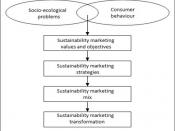Steps of the Marketing plan as suggested by MacDonald (2000), explain what each steps means to a company.
In the increasingly competitive markets and complex environment in which companies operate, marketing has turned to become an asset of many companies today. Marketing plays a vital role for companies big or small, to survive this globalization era. It is important for a company to have a good marketing strategy in order to achieve their goals and aims. This is the reason why marketing planning should be done as the plan states the marketing goals that the company wants to achieve within a certain time and the methods by which it intends to achieve those goals, as said by Mason, R. E. et al (1980). Moreover, as stated by Kotler et al (1999), the marketing plan is one of the most important outputs of the marketing process. Marketing planning as defined by McDonald (2000) is simply a logical sequence and a series of activities leading to the setting of marketing objectives and the formulation of plans for achieving them.
Through the use of a marketing plan, a company can be sure that all its bases like new markets, products, new methods as well as competition, are covered. However, as said by McDonald (2000), although marketing planning would appear to be a simple, step by step process, in reality, it is a multifaceted, complex, cross-functional activity that touches every aspect of organizational life. Furthermore, according to Evans & Berman (1990), a marketing plan should be well integrated in which all of its various parts are unified, consistent, and coordinated.
The following are the major steps of the marketing plan as suggested by McDonald (2000). These are steps that have to be gone through in order to arrive at a marketing plan.
Step 1: Mission statement
The marketing plan starts with a mission or purpose statement. According to Cole, G.A. (1994), a mission is a public statement on behalf of an organization which sets out its raison d etre in terms of the customer needs it intends to satisfy, the markets within which it will meet those needs, and the manner in which it will meet them. A mission statement is like the heart of a marketing plan. As said by McDonald (2000), a mission or purpose statement should include the role or contribution of the business, their definition, their distinctive competences as well as their indications for the future. It is essential for a company to have a good and clear mission statement as these statements "provide a vision of why the organization exists, where it intends to operate and how it intends to achieve its goals." Cole (1994). However, it is important for a mission to be sufficiently focused in its message for it to e understood, and believed in, by those affected by it.
Step 2: Setting corporate objectives
Since the mission statement are normally very broad, and are stated with such generality that it may not make the point clear enough; corporate objectives are formulated so that there is a more detailed view of the mission statement and can be beneficial to whoever needs it. Corporate objectives are "more finely focused statements of intent directed at those aspects of the organization's operations which are critical to success." Cole, G.A. (1994)
Step 3: The marketing audit
Marketing audit "is the means by which a company can understand how it relates to its environment in which it operates" McDonald (2000). The role of a marketing audit is relating the marketing mix factors to environmental, consumer, competitive and industry variables. As defined by Berkowitz, et al (1989), marketing audit is a comprehensive, unbiased, periodic review of the strategic marketing process of a firm. The purpose of a marketing audit is to identify new problems and opportunities that warrant an action plan to improve performance. By using marketing audit, before a firm steps any further, as stated by Berkowitz et al (1989), the firm can determine where is it now through a situation analysis which includes marketing mix factors, customer profiles, and market as well as competitor analysis. A company can perform both internal and external audits as it helps to collect and analyze the information available in the business environment so as to help them in problem solving.
Step 4: SWOT analyses
According to McDonald (2000), after conducting the marketing audit, a SWOT analysis is done. A SWOT is the summary of the audit under the heading internal strengths and weaknesses as they relate to external opportunities and threats. As defined by Berkowitz et al (1989), SWOT refers to a simple, effective technique a firm can use to appraise in detail its strengths, weaknesses, opportunities and threats. The goal of a SWOT analysis is to identify critical strategy-related factors that can have "a major effect on the firm and then build on vital strength, correct glaring weaknesses, exploit significant opportunities, and avoid disaster-laden threats" Berkowitz et al (1989).
Step 5: Assumptions
After completing the marketing audit and SWOT analysis, assumptions should be made. As said by McDonalds (2000), there are certain key determinants of success in all companies about which assumptions have to be made before the planning process can proceed. Assumptions have to be made carefully and should be few in number, and if a plan is possible irrespective of the assumptions made, then the assumptions are unnecessary.
Step 6: Marketing objectives and strategies
"An objective is what you want to achieve. A strategy is how you plan to achieve your objectives." Mcdonald (2000). Marketing objective concerns about product and market only, they are simply about existing products in existing market or new markets and also new products for existing/new markets. As said by Evans & Berman (1990), marketing objectives are highly customer oriented as the main focus is to get as many customers as possible for the benefit of the company.
Marketing strategy outlines the manner in which the marketing mix is used to attract and satisfy target markets and accomplish the organization's objectives, as pointed out by Evans and Berman (1990). They are generally concerned with the four P's or also known as the marketing mix. The 4 p's are product, price, place, and promotion. According to mason et al(1980), they are the core of any company's marketing system as they focuses on the customers, and the most effective combination of the 4 p's is the right marketing mix for a particular product or services.
Step 7: Estimate expected results
In order to estimate future results, at this stage, according to McDonald (2000), companies have to employ judgment, analogous experience, field tests, and others to test out the achievability of the objectives and strategies which have been done above.
Step 8: Identify alternative plans and mixes
Companies should always prepare back up or alternative marketing plans, as these alternatives can serve as an aid during an event of a strategic failure. Additionally, this can help companies to prevent both major or minor loses that may arise in the future.
Step 9: The budget
In any company, according to McDonald (2000), the strategies in their marketing plan would normally be costed out approximately. This helps companies to have a forecast of their expenditures and revenues for a specific period of time. As a planning document, a budget enables businesses, or organizations to set priorities and monitor progress toward their selected goals. If the budget is not practicable, as said by McDonald (2000), alternative strategies cold be proposed and costed out until a satisfactory solution could be reached.
Step 10: First year detailed implementation programme
After preparing all the nine steps above, the time has come to implement those steps to action so that the goals and objectives are achievable. Here the general marketing strategy would be developed into specific sub-objectives, each supported by more detail strategy and action statements. However too much details should be avoided as it is inefficient to the company.
On the whole the marketing plan "is a critical element in coordinating activities and budget" Guiltinan et al (1997). Furthermore, the effectiveness of the marketing plan depends on the quality of the efforts made by those who do the plans. According to Guiltinan et al (1997), in organizations that are truly market-oriented the marketing plan is likely to be viewed as a very important management activity for them to increase revenues and move forward to become more successful.
Even so, according to McDonald (2000), a written strategic marketing plan is the backdrop against which operational decision are taken. Its major function is to determine where the company is, where it wants to go and how to get there. It should be distributed on a need to know basis only. It should be used as an aid to effective management and not be a substitute for it.
References
- McDonald, M. (2000), Marketing Plans, Butterworth-Heinemann Publications, London.
- Mason, R. E. et al (1980), Marketing - Practices and Principles, McGraw-Hill Inc., USA.
- Kotler, P. et al (1999), Marketing Management - An Asian Perspective, Prentice Hall, Singapore.
- Evans, J. R. and Berman, B. (1990), Marketing, Macmillan Publishing, USA.
- Cole, G. A. (1994), Strategic Management - Theory and Practices, DP Publications Ltd., London.
- Berkowitz, E. N. et al (1989), Marketing, Irwin Publications, USA.
- Guiltinan, J. P. et al (1997), Marketing Management - Strategies and Programs, Irwin McGraw-Hill Publications, USA.


